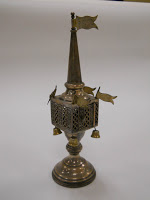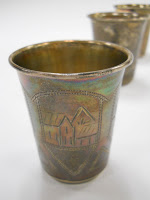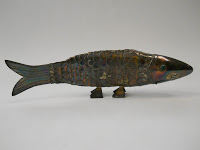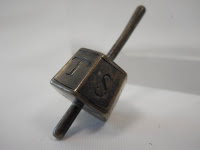Bernice and Henry Tumen Collection
September 27, 2011
Description by Zachary Fine Albert, Archives and Special Collections Assistant and MA candidate in Near Eastern and Judaic Studies
 The Robert D. Farber University Archives and Special Collections Department at Brandeis University houses 177 Jewish ceremonial objects, as well as rare Israeli coins and books on Judaica and Jewish ceremonials, given by Bernice and Henry J. Tumen in 1981. The collection principally showcases nineteenth- and twentieth-century religious artifacts, although it also contains Roman glass and clay pieces from the first to the fourth century. The ceremonials in the collection originate from many parts of Europe and the Near East, as well as areas of North Africa and America.
The Robert D. Farber University Archives and Special Collections Department at Brandeis University houses 177 Jewish ceremonial objects, as well as rare Israeli coins and books on Judaica and Jewish ceremonials, given by Bernice and Henry J. Tumen in 1981. The collection principally showcases nineteenth- and twentieth-century religious artifacts, although it also contains Roman glass and clay pieces from the first to the fourth century. The ceremonials in the collection originate from many parts of Europe and the Near East, as well as areas of North Africa and America.
 The collection grants researchers direct “confrontation with objects embodying Jewish culture and history,” and attests to the Jewish importance of the prescription of ritual needs.[1] Individually, these items illustrate the significance of the use of beauty in the performance of commandments and serve as tangible witnesses to the love of God and Torah. Collectively, they illuminate the communities and environments that informed, challenged and stimulated their creation and application. The history of Jewish ceremonial art and objects expresses itself within the historical experiences of Jews living among diverse cultures in dynamic and complex lands. As Jews constructed and understood their religio-cultural identities, they did so as a minority group that attempted to reconcile traditional religious duty with a surrounding folk-art influence. The works of Jewish ceremonial art in this collection reflect this tension and illuminate the artistic expression that blossomed under the constraints of fulfilling the requirements of Jewish Law.
The collection grants researchers direct “confrontation with objects embodying Jewish culture and history,” and attests to the Jewish importance of the prescription of ritual needs.[1] Individually, these items illustrate the significance of the use of beauty in the performance of commandments and serve as tangible witnesses to the love of God and Torah. Collectively, they illuminate the communities and environments that informed, challenged and stimulated their creation and application. The history of Jewish ceremonial art and objects expresses itself within the historical experiences of Jews living among diverse cultures in dynamic and complex lands. As Jews constructed and understood their religio-cultural identities, they did so as a minority group that attempted to reconcile traditional religious duty with a surrounding folk-art influence. The works of Jewish ceremonial art in this collection reflect this tension and illuminate the artistic expression that blossomed under the constraints of fulfilling the requirements of Jewish Law.
 Rabbi and scholar Arthur Hertzberg maintains that “Judaism is a way of life that endeavors to transform virtually every human action into a means of communion with God.”[2] The ritual objects that accompany ceremonies and festivals become the most tangible expressions of this relationship. As public displays of religious observance, these ceremonials were carefully and beautifully constructed. Jewish communities cite a rabbinic interpretation of Exodus 15:2, “This is my God, and I will glorify him,” as the impetus for hidur mitzvah, performing religious commandments in the most beautiful manner possible. Not an exception to the rule, the Bernice and Henry Tumen collection contains intricate silverwork and incorporates precious gemstones. A nineteenth-century Torah crown fashioned from red velvet includes seed pearls and floral designs, and an ivory European Torah pointer is decorated in silver with an inset turquoise stone. None of these Torah ornaments would have been viewed as “merely a utilitarian device”; instead the “beauty in [these] works of art symbolized the exalted position of the Torah in Jewish life.”[3] It is no coincidence that their artistic beauty derives from an understanding that religious experience is “more commonly absorbed through the senses than through the intellect.”4 Interestingly, the text Ma’aseh Efod of Profiat Duran of Spain (also known as Isaac ben Moses ha-Levi, circa 1360 to circa 1414) concludes that it is through the theme of aesthetic value in religious ceremony that one gains intelligence:
Rabbi and scholar Arthur Hertzberg maintains that “Judaism is a way of life that endeavors to transform virtually every human action into a means of communion with God.”[2] The ritual objects that accompany ceremonies and festivals become the most tangible expressions of this relationship. As public displays of religious observance, these ceremonials were carefully and beautifully constructed. Jewish communities cite a rabbinic interpretation of Exodus 15:2, “This is my God, and I will glorify him,” as the impetus for hidur mitzvah, performing religious commandments in the most beautiful manner possible. Not an exception to the rule, the Bernice and Henry Tumen collection contains intricate silverwork and incorporates precious gemstones. A nineteenth-century Torah crown fashioned from red velvet includes seed pearls and floral designs, and an ivory European Torah pointer is decorated in silver with an inset turquoise stone. None of these Torah ornaments would have been viewed as “merely a utilitarian device”; instead the “beauty in [these] works of art symbolized the exalted position of the Torah in Jewish life.”[3] It is no coincidence that their artistic beauty derives from an understanding that religious experience is “more commonly absorbed through the senses than through the intellect.”4 Interestingly, the text Ma’aseh Efod of Profiat Duran of Spain (also known as Isaac ben Moses ha-Levi, circa 1360 to circa 1414) concludes that it is through the theme of aesthetic value in religious ceremony that one gains intelligence:
Study should always be in beautiful books, pleasant for their beauty and the splendor of their scripts and parchments, with elegant ornament and covers. And the places for study should be desirable, the study halls beautifully built so that people’s love and desire for study will increase. Memory will also improve since contemplation and study occur amidst beautifully developed forms and beautiful drawings, with the result that the soul will expand and be encouraged and strengthen its powers… It is also obligatory and appropriate to enhance the books of God and to direct oneself to their beauty, splendor and loveliness. Just as God wished to adorn the place of His Sanctuary with gold, silver and precious stones, so is this appropriate for His holy books, especially for the book which is “His Sanctuary” [the Bible].[5]
Immense efforts were made to produce beautiful items and beautiful scrolls “written in good ink, with good pens, by competent scribes, and covered with fine silks.”[6]
 This yearning for holy beauty on earth continued with the emergence of Kabbalah, Jewish mysticism, as one finds amulets and talismans growing in popularity. Jewish amulets, emphasizing religious texts and names, were worn for purposes of protection (against sickness, misfortune and the “evil eye”). Many of the pieces in this collection can be worn as an ornament and contain the word Shaddai or the Hebrew letter shin. It should be noted that while amulets were quite popular among the medieval European and early modern Mediterranean Jewish population, they have been frequently denounced by some rabbinical authorities as mere superstition.
This yearning for holy beauty on earth continued with the emergence of Kabbalah, Jewish mysticism, as one finds amulets and talismans growing in popularity. Jewish amulets, emphasizing religious texts and names, were worn for purposes of protection (against sickness, misfortune and the “evil eye”). Many of the pieces in this collection can be worn as an ornament and contain the word Shaddai or the Hebrew letter shin. It should be noted that while amulets were quite popular among the medieval European and early modern Mediterranean Jewish population, they have been frequently denounced by some rabbinical authorities as mere superstition.


 The various intercultural factors that inspired Jewish ceremonial art are also well documented. This collection contains Christian, Dutch, Greek and Islamic influences, to name a few. One can find a nineteenth-century Christian censer transformed into a Jewish spice box, a hexagonal Dutch dreidel inscribed with Latin letters, and a nineteenth-century Near Eastern menorah backplate with nine mihrabs. (In the mosque a mihrab indicates the direction of the Kaaba in Mecca, and therefore should be the direction of prayer). Additionally, the collection’s spice containers display an unmatched receptiveness to outside influence. No other ritual object shows “as many variations as the spice container.”[7] There is no Jewish law that dictates what kind of box should be used, and, moreover, no law describing which type of spice should be contained. During the Havdalah ceremony, sweet spices are employed to counteract the sadness of Shabbat’s departure and to remember the joy of the holiday. The oldest pieces preserved have “the well-known tower form which originated in the tower-like incense containers of the Near East.” In the medieval period in Western countries,“spices were very precious and therefore kept in the tower of the city fortification, which makes it understandable that the medieval tower was reproduced for the spice containers in the European west.”[8] From the sixteenth century on, Christian smiths crafted a large portion of the spice boxes in Europe and used forms familiar to them from Catholic ritual objects. In a 1558 notation in a silversmith’s book, the smith explains he has crafted a Jewish “monstrance”—a style that “reflects the Gothic architectural forms used in church ritual items of the time.”[9]
The various intercultural factors that inspired Jewish ceremonial art are also well documented. This collection contains Christian, Dutch, Greek and Islamic influences, to name a few. One can find a nineteenth-century Christian censer transformed into a Jewish spice box, a hexagonal Dutch dreidel inscribed with Latin letters, and a nineteenth-century Near Eastern menorah backplate with nine mihrabs. (In the mosque a mihrab indicates the direction of the Kaaba in Mecca, and therefore should be the direction of prayer). Additionally, the collection’s spice containers display an unmatched receptiveness to outside influence. No other ritual object shows “as many variations as the spice container.”[7] There is no Jewish law that dictates what kind of box should be used, and, moreover, no law describing which type of spice should be contained. During the Havdalah ceremony, sweet spices are employed to counteract the sadness of Shabbat’s departure and to remember the joy of the holiday. The oldest pieces preserved have “the well-known tower form which originated in the tower-like incense containers of the Near East.” In the medieval period in Western countries,“spices were very precious and therefore kept in the tower of the city fortification, which makes it understandable that the medieval tower was reproduced for the spice containers in the European west.”[8] From the sixteenth century on, Christian smiths crafted a large portion of the spice boxes in Europe and used forms familiar to them from Catholic ritual objects. In a 1558 notation in a silversmith’s book, the smith explains he has crafted a Jewish “monstrance”—a style that “reflects the Gothic architectural forms used in church ritual items of the time.”[9]
Linda A. Altschuler and Anna R. Cohn in “The Precious Legacy: Judaic Treasures from the Czechoslovak State Collections” contemplate the continuity of the Jewish experience:
"The artifacts are from another time and place. Yet most of these objects would be as much at home in Jewish life today as in any time gone by. […] While the artistic forms of Jewish ceremonial art vary in response to the different periods and environments in which they are made, the functions of Judaic objects are rooted in time-honored laws and traditions.[10]"
 The items in the Bernice and Henry Tumen collection speak to a living tradition—a tradition that explains, “All things of the natural world provide opportunities for sanctification” from birth to death.[11] In an attempt to sanctify time and remember history, the physical and spiritual natures of humanity are inseparable. The spiritual has the power to inform the physical, which in turn attempts to recreate the spiritual. As Abraham Joshua Heschel remarks, “We cannot make [God] visible to us, but we can make ourselves visible to [God].”[12]
The items in the Bernice and Henry Tumen collection speak to a living tradition—a tradition that explains, “All things of the natural world provide opportunities for sanctification” from birth to death.[11] In an attempt to sanctify time and remember history, the physical and spiritual natures of humanity are inseparable. The spiritual has the power to inform the physical, which in turn attempts to recreate the spiritual. As Abraham Joshua Heschel remarks, “We cannot make [God] visible to us, but we can make ourselves visible to [God].”[12]
 The Bernice and Henry Tumen collection demonstrates the complex interactions between tradition and continuity and art and beauty in the substance of everyday life. This collection represents an invaluable resource for any student of nineteenth- and twentieth-century European Jewish history, intercultural studies, religious ceremonies and ceremonials, Jewish symbols and superstitions, silverwork and jewelry studies, and even the art of collecting itself.
The Bernice and Henry Tumen collection demonstrates the complex interactions between tradition and continuity and art and beauty in the substance of everyday life. This collection represents an invaluable resource for any student of nineteenth- and twentieth-century European Jewish history, intercultural studies, religious ceremonies and ceremonials, Jewish symbols and superstitions, silverwork and jewelry studies, and even the art of collecting itself.
For more information regarding the Bernice and Henry Tumen collection, please consult the finding aid..
A portion of the Tumen collection is on display in the cases on the mezzanine level of Goldfarb Library.
Notes:
 Mann, Vivian B. and Bilski, Emily D. The Jewish Museum New York. Scala Books, 1993, 18.
Mann, Vivian B. and Bilski, Emily D. The Jewish Museum New York. Scala Books, 1993, 18.- Hertzberg, Arthur. Judaism. New York: Braziller, 1961, 73-74.
- Altshuler, David, ed. The Precious Legacy: Judaic Treasures from the Czechoslovak State Collections. New York: Summit Books, 1983, 122.
- Kanof, Abram. Jewish Ceremonial Art and Religious Observance. New York: Harry N. Abrams, Inc., 1970, 9.
 Duran, Profiat. Sefer Ma’aseh Efod. Vienna: Yom-Tov Friedlander and Jacob haKohen, 1891, 19.
Duran, Profiat. Sefer Ma’aseh Efod. Vienna: Yom-Tov Friedlander and Jacob haKohen, 1891, 19.- B. Shabbat 133b. (Babylonian Talmud)
- Kayser, Stephen S., ed. Jewish Ceremonial Art. The Jewish Publication Society of America: Philadelphia, 1955, 89.
- Ibid., 89.
 The Sherwin Miller Museum of Jewish Art. "Permanent Collection – Ritual Objects."
The Sherwin Miller Museum of Jewish Art. "Permanent Collection – Ritual Objects."- Altschuler, ed. The Precious Legacy. New York: Summit Books, 1983, 207.
- Ibid., 207.
- Heschel, Abraham Joshua. Man’s Quest for God. New York, 1954, 5.